SES 16 / GovSat
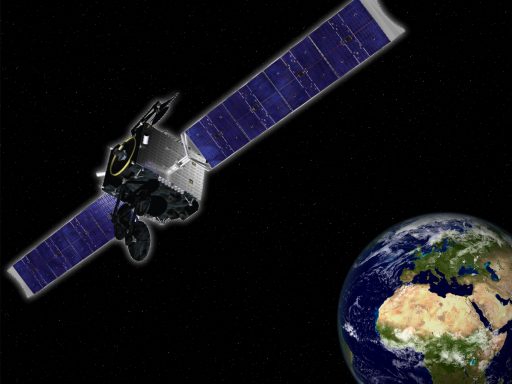
SES 16 / GovSat is a communications satellite operated by LuxGovSat, a joint venture between commercial satellite operator SES and the Government of Luxembourg to create a satellite for military/government and institutional applications. The satellite was built by Virginia-based Orbital ATK using the company’s GEOStar-3 satellite platform that debuted earlier in 2018 on the Al Yah 3 mission, making SES 16 only the second satellite to employ this particular platform.
SES 16, operated by LuxGovSat S.A., will “provide secure, reliable and accessible satellite communication services for governments, addressing connectivity demands for defence and institutional security applications,” according to parent company SES. The ~4-metric-ton satellite hosts a multi-mission payload comprising a secure X-Band payload for government use and a military Ka-Band payload for data-intensive services. One novelty for SES 16 is the existence of a special port on the satellite that can welcome a hosted payload arriving via docking in orbit.
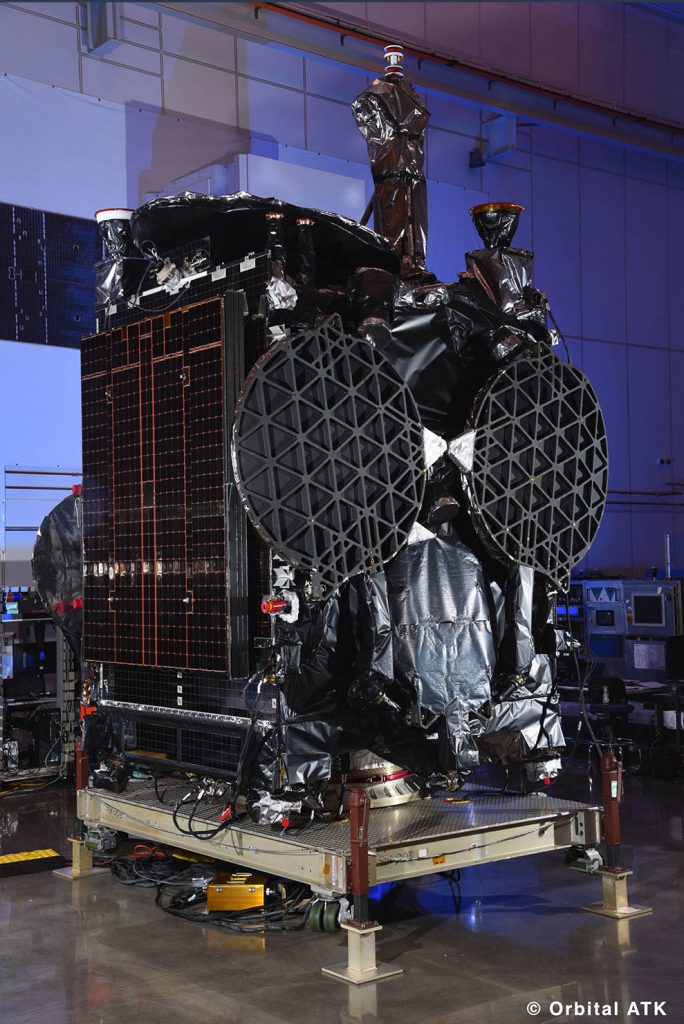
LuxGovSat ordered the satellite from Orbital ATK in February 2015 as the 40th GEOStar-based satellite sold by the company and the third in the advanced GEOStar-3 platform series.
SES 16 / GovSat provides bandwidth exclusively to government and defence users via dedicated military frequencies in X- and Ka-Band, utilizing a combination of high-powered, steerable spot beams as well as wide-area coverage for a variety of secure communications, high-throughput or mobility operations. The satellite’s coverage area extends across Europe, Africa, the Middle East and extensive maritime coverage exists over the Mediterranean and Baltic Seas as well as the Atlantic and Indian Oceans.
The X-Band payload delivers a global beam covering a wide area from 50°W to 90°E and 70°N and 70°S supporting various secure communications links with a capability compliant with NATO’s stated Level of Ambition of a Major Joint Operation. Multiple-Mission Beams that are fully steerable can direct focused coverage on key mission areas, supporting critical and secure communications for localized theaters.
The Military Ka-Band comprises an Anchor Beam and, like the X-Band, also delivers Multiple-Mission beams with high-power characteristics. The Anchor Beam spans the entire European Continent and will mainly be used for interconnecting headquarters, government institutions or defence sites within Europe while the Multi-Mission Beams enable high-bandwidth and data-intensive applications over small antennas. The Ka-Band Multi-Mission architecture is primarily geared toward Intelligence, Surveillance and Reconnaissance (ISR) and Communications on the Move (COTM).
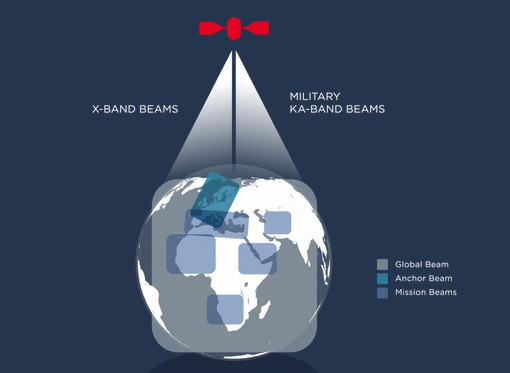

Naturally, with a mission of this nature, security and encryption are two major factors driving the design and operation of the satellite. Capacity on SES 16 / GovSat is to be sold “on a non-preemptable basis,” giving users full control over the management of their services in a full or fractional transponder basis (MHz). Ground stations supporting the mission are fully accredited to handle EU NATO traffic and connect to terrestrial VPN/MPLS networks to provide landline connectivity. GovSat employs advanced anti-jamming technology to ensure its services can not be tampered with and are available on a 24/7 basis.
Applications supported by SES 16 / GovSat are broken down in two categories: a) Institutional Security Applications (e.g. inter-agency collaboration, strategic and tactical networks, emergency response, disaster management & recovery, protection of natural resources and connecting remote government offices) and b) defence applications (e.g. remote military operations, Communications on the Move COTM, Communications on the Pause COTP, maritime operations, aero operations for ISR).
SES 16 / GovSat will be positioned at 21.5 degrees east in Geostationary Orbit for a design life of 15 years, though the satellite is fueled for at least 16 years of operations in Geostationary Orbit. The Government of Luxembourg has pre-committed to a significant fraction of the satellite’s capacity to support the country’s NATO obligations; the remaining capacity will be made available to government and institutional customers.
When GovSat was announced, SES also introduced a unique capability of the satellite in the form of a special port that would allow the satellite to receive hosted payloads in orbit. No payload for this port was identified, but it can reportedly support 200-Kilogram, 500-Watt payloads that maneuver to dock with the satellite after being released in proximity to it. If, when and where this capability is to be tested remains unknown.
GEOStar-3

The GEOStar-3 satellite platform represents Orbital ATK’s largest satellite bus to date, leveraging experience from the company’s GEOStar-2 platform series and catering to an emerging class of satellites aiming for high-performance while keeping mass and volume low – requiring innovations in the area of power generation and electric propulsion.
Orbital ATK’s GEOStar-2 product line has flown successfully on nearly three dozen missions since 2002 with satellites in the 1.9 to 3.3-metric ton class and a payload power of up to 5.0 Kilowatts. The company cites the prime advantage of the GEOStar-2 in its small size yet high performance characteristics, allowing it to be launched cost-effectively as lower-berth passenger on Europe’s Ariane 5 rocket or slots with comparable performance on other vehicles.
The GEOStar-3 satellite platform relies on robust heritage from the smaller GEOStar-2 with performance improvements in critical areas like power generation, structure and hybrid propulsion to create a low-mass platform with a high payload capacity, both in terms of mass and power. GEOStar-3 has been designed for satellites in the 3.5 to 4.5-metric-ton class and an end-of-life power up to 8 Kilowatts.
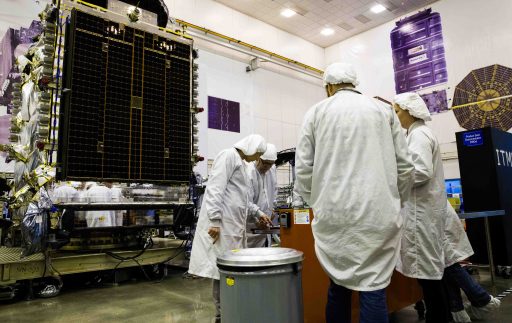
To satisfy the power demands of high-powered communications payloads, GEOStar-3 implements a number of enhancements within its Electrical Power System including an increase in solar array size and power output via Ultra-Triple-Junction Gallium-Arsenide solar cells and increased capacity of the vehicle’s Li-Ion batteries. Retained from the previous generation of Orbital ATK platforms is the 36-Volt power architecture that has proven very effective with a 100% success rate.
Structural improvements through the use of composite materials led to a decrease in bus dry mass while creating an optimal load-carrying capability and propellant tank accommodation. The satellite platform structure also allows for tandem launches and GEOStar-3 has been optimized for use as a hybrid satellite bus carrying conventional bi-propellant main and attitude thrusters for orbit-raising operations while Stationkeeping is either handled by the heritage ImpEHTs pulsed plasma thrusters or a new type of flight-proven Electric Propulsion System with increased performance characteristics (see below).

The GEOStar-3 bus can accommodate payloads up to 800 Kilograms and 8,000 Watts. Its thermal management system can support up to 72 radiatively-cooled Traveling Wave Tube Amplifiers or a larger number of TWTA’s employing a combination of radiative and conductive cooling. GEOStar-3’s scalable thermal control system can dissipate up to 4,800 Watts of heat, allowing it to host high-power communications packages.
Leveraging decades of experience in space-based deployables, GEOStar-3 can support a variety of deployable reflectors and nadir-facing antenna configurations. The platform can also host custom-fabricated appendages and various hosted payloads to broaden its operational use beyond the scope of communication missions.
The hybrid propulsion concept employed by GEOStar-3 relies on a liquid-fueled bi-propellant main engine for orbit transfer from the satellite’s initial injection orbit into a near-geostationary orbit with hydrazine monopropellant thrusters in use for attitude control before and during main engine burns.

The Xenon Hall Current Thrusters of the satellite are employed for ‘orbit topping’ – transitioning from the near-GEO orbit into a stable GEO at the satellite’s desired position. Stationkeeping will primarily use the electric propulsion system, though the thrusters are available to use propellant reserves and extend the satellite’s stationkeeping capability.
SES 16 employs an IHI BT-4 main engine which has been used abundantly by Orbital ATK on the company’s geostationary satellites as well as the prime maneuvering thruster of the Cygnus cargo spacecraft servicing the International Space Station. BT-4 was developed by IHI Aerospace, Japan and has a dry mass of 4 kilograms and a length of 0.65 meters. The engine provides 450 Newtons of thrust using Monomethylhydrazine fuel and Nitrogen Tetroxide oxidizer. The attitude control thrusters rely on the catalytic decomposition of Hydrazine over a metallic catalyst bed into gaseous reaction products expelled to create thrust.
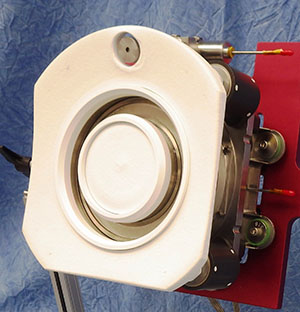
The satellite hosts four 4-Kilowatt-class XR-5 Xenon Hall Current Thrusters developed and built by Aerojet Rocketdyne. XR-5 has successfully flown on the U.S. Air Force AEHF communications satellites and a modernized version, XR-5A, successfully completed testing on the fourth mission of the X-37B Orbital Test Vehicle.
XR-5 was developed in the 2000s and has operated extensively in orbit at power levels of 3.0 to 4.5 Kilowatts at both 300 V and 400 V. Using zero-erosion technology, the XR-5 has been demonstrated to support over 10,000 hours of operation and over 7,000 starts. Its operational flexibility for power and voltage allows an optimization between mass and cost savings by allowing low-voltage, high-thrust operation of the thruster during orbit topping to accelerate the in-service date for the satellite while the high-voltage, high-impulse setting allows for efficient and prolonged stationkeeping over extended mission durations to allow satellites to drive in revenue beyond their expected service lives.
At their baseline setting, each XR-5 thruster delivers 280 Millinewtons of thrust at a specific impulse of 1,815 seconds. Through extensive ground testing, the performance map of the XR-5 could be broadened to power settings between 1 and 5.5 Kilowatts, allowing for high-impulse operation up to an Isp of 2,700 seconds. The total impulse expected for the thruster’s service life and a throughput of 450 Kilograms of Xenon is in excess of 8 MN-s.
